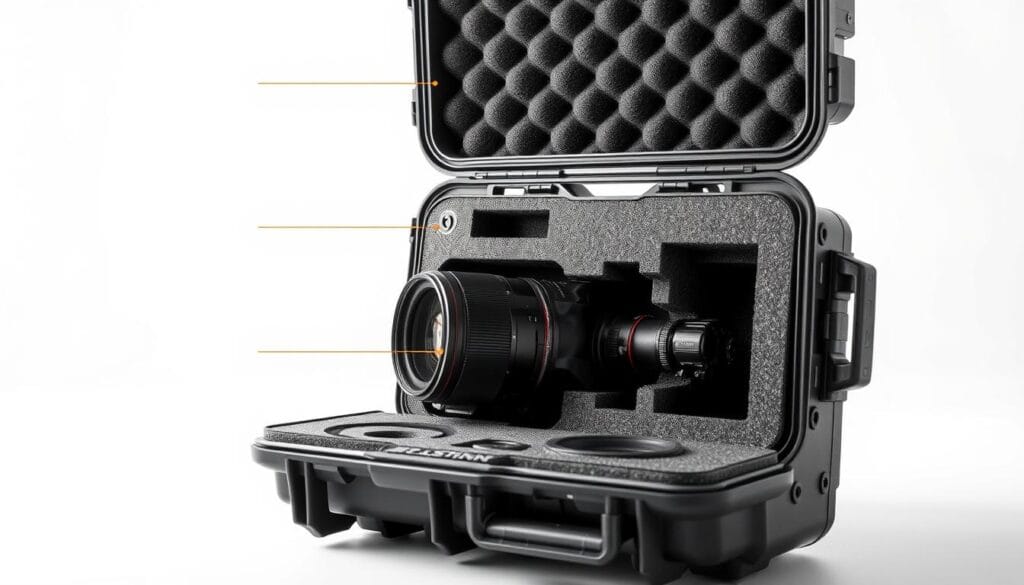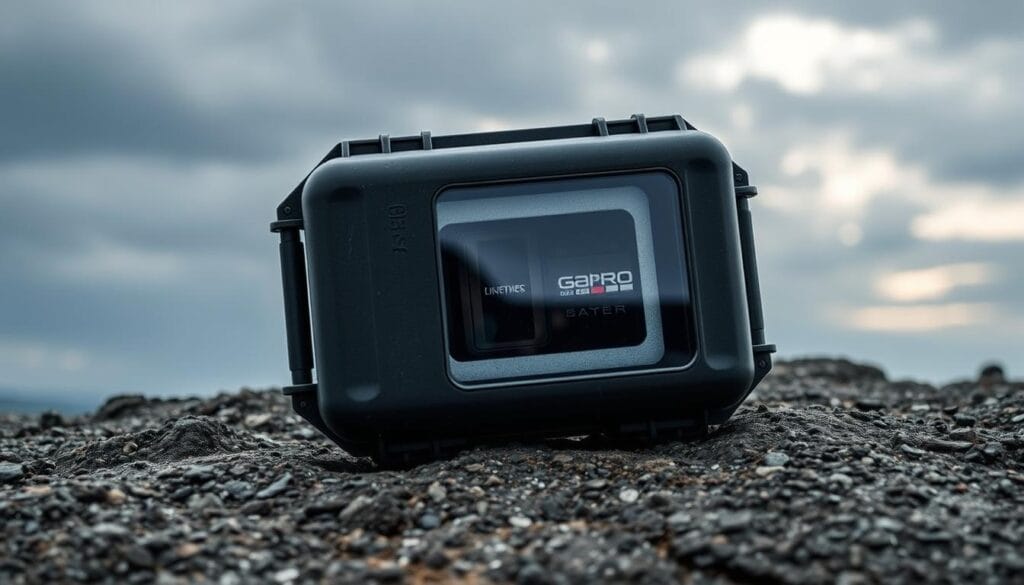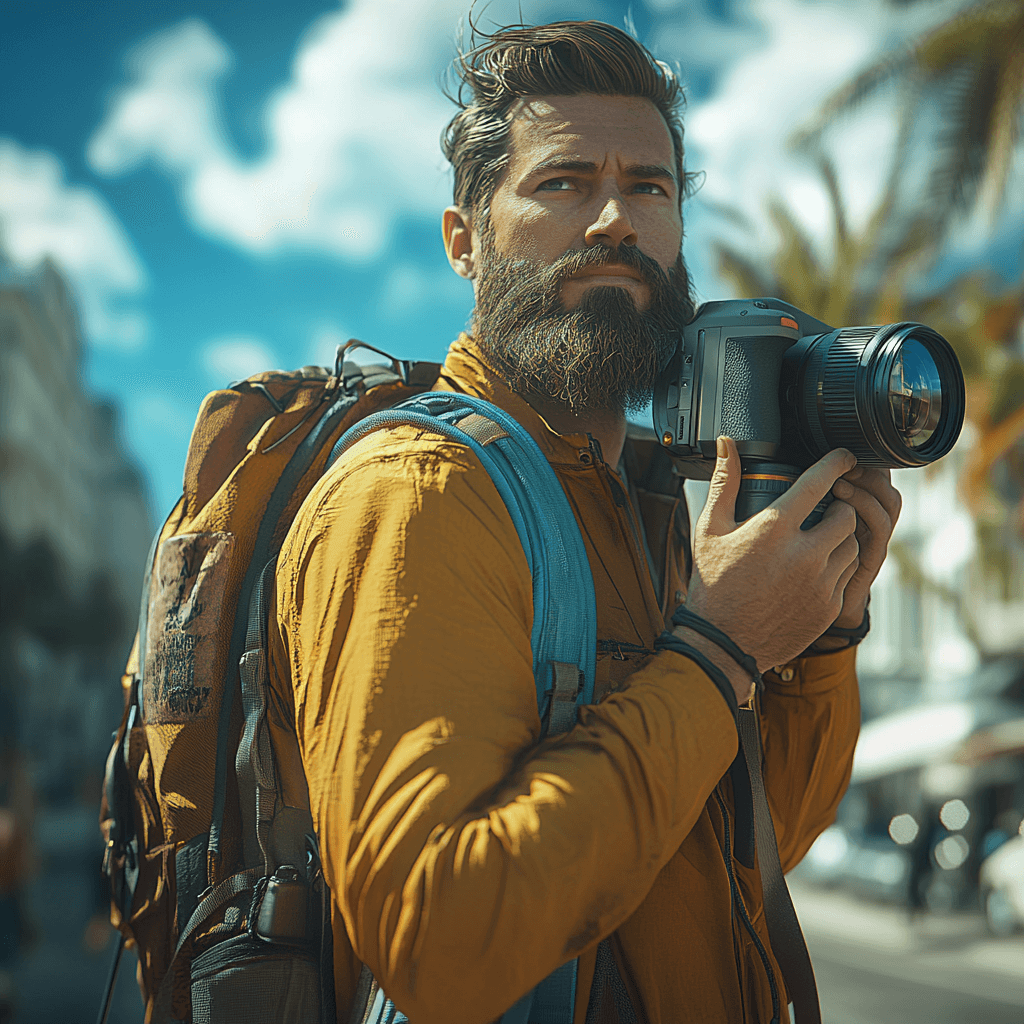Best Travel Case for Camera: Protect Your Gear
Every photographer knows the fear of their camera slipping or getting bumped. A good travel case for your camera is more than just an accessory. It’s a lifeline for your valuable photography equipment. Both professional and amateur photographers know how important it is to protect their gear on any journey.
Today, camera bags come in many styles, from small messenger bags to big backpacks. Since 80% of photographers carry their cameras on flights, picking the right bag is key. Your equipment is an investment that needs protection from damage, weather, and unexpected travel risks.
If you’re a light traveler or a pro with many cameras, there’s a perfect bag for you. Knowing what you need helps you find a bag that protects, is easy to use, and convenient.
Table of Contents
Understanding Camera Protection Essentials
Protecting your camera gear is key for photographers on the move. Whether you’re a pro or just starting, knowing the basics of camera protection can prevent damage and disappointment.
Choosing a durable camera case involves several important factors. Your gear needs strong protection against many dangers.
Impact Protection Features
Camera safety begins with shock absorption. Good cases have several layers to protect:
- Padded interior walls
- Shock-absorbing foam inserts
- Reinforced exterior shells
- Customizable divider systems
Weather Resistance Requirements
Photographers need cases that handle different weather. Important weather-resistant features include:
| Feature | Protection Level |
|---|---|
| Water-repellent materials | Prevents moisture penetration |
| Sealed zippers | Blocks dust and light rain |
| Rubberized coatings | Enhanced environmental resistance |
Material Considerations
The right material is crucial for your camera’s safety. Durable camera case materials vary from light nylon to tough polycarbonate. Each has its own benefits for different photography styles.
- Nylon: Lightweight and flexible
- Polycarbonate: Extremely strong and impact-resistant
- Ballistic fabric: High-performance protective gear for cameras
By picking the right protective gear for cameras, you’ll keep your equipment safe on your photo trips.
Types of Travel Case for Camera Solutions
Choosing the right camera carrying case is key to keeping your gear safe while traveling. Photographers have many options, each suited for different needs and settings.
- Backpack-Style Cases: Great for carrying lots of gear and for outdoor trips
- Messenger Bags: Ideal for city photographers who need quick access
- Rolling Cases: Best for those with heavy equipment
- Modular Systems: Offers the most customization
Each travel situation calls for a specific camera carrying method. For example, adventure photographers might choose rugged backpacks like the Shimoda Explore V2. Street photographers might prefer smaller sling bags.
| Case Type | Capacity | Best For |
|---|---|---|
| Backpack | 20-35 Liters | Multiple Cameras, Lenses |
| Messenger Bag | 6-10 Liters | Mirrorless, Small DSLR |
| Rolling Case | 35-45 Liters | Professional Equipment |
Your camera storage solution should protect your gear, be easy to access, and be comfortable. Think about your photography needs, travel style, and equipment when choosing.
Key Features to Look for in Camera Cases
Finding the right padded camera case is key to keeping your gear safe. With 85% of users saying protection is top priority, knowing what to look for is important.

When looking for camera accessories, focus on safety and ease of use. These features ensure your equipment is well-protected and easy to access.
Padding and Shock Absorption
Good padding is the first step in protection. A top-notch padded camera case should have:
- Thick, shock-absorbing interior materials
- Customizable dividers to separate equipment
- Impact-resistant exterior shell
75% of photographers like bags with dividers to keep gear safe during transport.
Size and Weight Considerations
Your camera case needs to be both protective and portable. Think about these points:
- Choose a case that fits your camera setup
- Opt for light materials to avoid strain
- Go for a compact design for easy travel
Interestingly, 55% of DSLR users need bigger bags than mirrorless users because of size differences.
Accessibility Options
Camera accessories should make access easy. Look for:
- Quick-release compartments
- Multiple entry points
- External attachment points for tripods
40% of users pick bags for quick access, especially in city photography.
Backpack-Style Camera Caseshttps://www.nextstopin.com/travel-tips/
Backpack-style camera cases are perfect for travel photography. They offer comfort and versatility. These designs let photographers carry their gear easily while keeping it safe.
Many professional photographers choose backpack-style camera bags. Here’s why:
- Ergonomic design with padded shoulder straps
- Even weight distribution across the back
- Multiple compartments for camera bodies and lenses
- Additional space for personal items and accessories
The best camera bags in this category have great features like:
- Side-access panels for quick gear retrieval
- Modular internal organization systems
- Weatherproof materials
- Dedicated laptop and tablet compartments
“A great camera backpack isn’t just about storage—it’s about seamless integration with your photography workflow.” – Professional Travel Photographer
When picking your camera bag, think about what you need. Look for brands like Peak Design, Nomatic, and Lowepro. They have options from small 20-liter bags to big 45-liter adventure packs.
Rolling Camera Cases for Travel
Photographers who travel a lot face the challenge of carrying their camera gear safely. Rolling camera cases are a great solution. They protect your gear and make it easier to carry.
Choosing the right rolling camera case is important. It affects how safe and easy it is to carry your photography equipment while traveling.
Airline Compatibility Considerations
When picking a rolling camera case, think about airline rules. Most pros look for these things:
- It must fit in carry-on bags
- It should have TSA-approved locks
- It needs to protect fragile gear well
Wheel System Innovations
There are different wheel types for photographers on the move:
| Wheel Type | Maneuverability | Best Use |
|---|---|---|
| Two-Wheel Design | Good on rough surfaces | Outdoor photography trips |
| Four-Wheel Spinner | Excellent in airports | Urban travel and studios |
Handle Mechanism Performance
The handle of your travel case is key. Look for telescoping handles with grips that are easy to hold. They should extend smoothly. Choose durable materials like aluminum for lasting use.
Waterproof and Weather-Resistant Options
Choosing the right waterproof camera case is key for photographers in tough spots. They need gear that can handle bad weather. This is crucial for keeping cameras safe.

- IP-rated water resistance levels
- Material durability
- Specialized sealing technologies
- Environmental adaptability
NANUK hard cases are top-notch for waterproof protection. They’re made of NK7 resin, which fights off water, dust, and impacts. These cases also have customizable foam to keep your camera safe in any situation.
“The right waterproof case doesn’t just protect your gear—it gives you confidence in any shooting environment.”
Different photographers need different levels of water protection. Some cases have removable rain covers, while others are fully waterproof. The Deco Gear 3-in-1 Travel Camera Case, priced at $129.99, is versatile. It’s made of high-density waterproof nylon and has a detachable rain fly.
When picking your waterproof camera case, think about:
- Water resistance rating
- Weight and portability
- Compatible equipment size
- Ease of access
Investing in quality protective gear for cameras ensures your equipment remains safe during outdoor adventures and professional shoots.
Organization Systems and Storage Solutions
Keeping your camera accessories safe is key. The right storage solutions make your gear easy to find and use. A good organization system changes how you carry and manage your photography tools.
For pros, camera storage is more than just holding things. Today’s cases have smart features for organizing your gear.
Divider Systems
Customizable divider systems are a big help. They let you:
- Make special spots for each item
- Keep delicate gear safe from bumps
- Change the setup as your gear changes
Accessory Pockets
Accessory pockets are essential for organizing your camera storage. Look for cases with special spots for:
- Memory cards
- Extra batteries
- Lens cleaning tools
- Filters and adapters
Quick Access Features
Modern cases have cool quick-access features. Top-loading compartments and side panel entries let you quickly get what you need without opening the whole case.
Choosing a good storage solution keeps your gear safe and makes your photography work easier.
Durability and Material Quality
Choosing a durable camera case is key to protecting your gear. It must handle travel and daily use well. Knowing about material quality and construction is crucial for lasting protection.
Different materials have their own benefits for photographers:
- Polycarbonate and polypropylene are great for impact and water resistance
- Ballistic nylon is light but still durable for daily use
- High-impact plastics make strong exterior shells for extra protection
When looking at a durable camera case, focus on these important points:
- Strong stitching
- Good hardware and zippers
- Fabric layers that resist wear
- Warranty coverage from the maker
Professional photographers say it’s smart to buy cases known for their durability. Brands like Peli’s Protector Cases and Storm Cases are top choices. Their Air case line is a great example, offering both light weight and strong protection.
Remember: A truly durable camera case is an investment in protecting your valuable photography equipment.
Your choice of camera case should fit your travel and use needs. This ensures your gear stays safe in many settings.
Size Options for Different Camera Setups
Choosing the right camera carrying case is key for travel photography. The market has many sizes to fit different cameras and needs. Mirrorless cameras are getting more popular, leading to smaller, more versatile cases.
DSLR cameras need strong, roomy cases because they can be heavy. Look for bags that spread out the weight well. They should also fit many lenses and accessories. Backpack-style cases are often the best for this.
Mirrorless cameras have changed how we store our gear. They need less bulky cases, making carrying easier. Choose bags with adjustable dividers to protect your equipment better. The goal is a case that’s not too big but still protects well.
Storing multiple lenses requires smart planning. Go for cases with modular parts that can change with your gear. Whether you have small cameras or big ones, the case should grow with you.

FAQ
How do I choose the right size camera case for my equipment?
Are waterproof camera cases necessary for all photographers?
What’s the difference between a camera backpack and a messenger bag?
How important are padded dividers in a camera case?
Can I use a rolling camera case as a carry-on when flying?
What materials provide the best protection for camera cases?
How do I maintain and clean my camera case?
Are modular camera cases worth the investment?
Source Links
- https://www.disneytouristblog.com/best-camera-bags-dslr/ – Choosing the Best Camera Bag for Travel – Disney Tourist Blog
- https://avcstore.com/blogs/blogs/travel-camera-cases-protect-your-gear-on-the-go?srsltid=AfmBOoouAWBDe0TLAr7UxEZsw2Q3hMGmYGhyq51F6ujigfMdoZWbb-BY – Travel Camera Cases: Protect Your Gear on the Go!
- https://wdophoto.com/2023/08/12/best-camera-travel-case/ – The Best Camera Travel Case Ever Made
- https://avcstore.com/blogs/blogs/travel-camera-cases-protect-your-gear-on-the-go?srsltid=AfmBOopDZ2fxEy8QPrH6_eoShs6cf0N23xAyPjqEAdtONeybg1e6vcMc – Travel Camera Cases: Protect Your Gear on the Go!
- https://www.photographytalk.com/essential-tips-for-traveling-with-camera-gear-keep-it-safe-keep-it-simple/ – Essential Tips for Traveling With Camera Gear: Keep It Safe, Keep It Simple
- https://digital-photography-school.com/how-to-keep-camera-gear-safe-while-traveling/ – Keep Your Camera Safe While Traveling: 13 Essential Tips
- https://www.travelandleisure.com/style/travel-accessories/chic-camera-bags – Protect Your Camera With These Travel Camera Cases
- https://www.ottsworld.com/blogs/best-camera-bag-for-travel/ – Best Camera Bag for Travel: Organized by Travel Style
- https://fstoppers.com/gear/best-camera-bag-adventure-and-traveling-556269 – Best Camera Bag for Adventure and Traveling
- https://www.manfrotto.com/us-en/stories/camera-bag-buying-guide/ – Camera Bag Buying Guide
- https://fstoppers.com/reviews/important-things-look-when-choose-camera-bag-681580 – Important Things to Look For When You Choose a Camera Bag
- https://www.wired.com/gallery/best-camera-bags-backpacks-straps-inserts/ – The Best Camera Bags, Straps, and Backpacks
- https://gearjunkie.com/technology/camera/best-camera-backpack – The Best Camera Backpacks of 2025
- https://www.pelican.com/us/en/products/cases/camera-cases – Camera Cases | Pelican
- https://www.digitalcamerawarehouse.com.au/rolling-cases?srsltid=AfmBOooL2cfi4COG3w-sYu7dMgkFmgzGNCryAySt7mifKTa1-bIri-Hl – Rolling Cases | Digital Camera Warehouse
- https://nanuk.com/collections/camera-cases?srsltid=AfmBOopoyZzCrm0cCqH7x50DODVgGwrQZvALLAEkxMSh-dLZ6RzX8OM_ – NANUK Camera Cases | Protective Camera Case Online Store
- https://www.beachcamera.com/products/deco-gear-3-in-1-travel-camera-case-waterproof-trolley-backpack-carry-on-bag-1?srsltid=AfmBOorR61A1DT3yt2fjMMxQ1BnPB3knzZf_IzGmm_S0rWHbVbpJhyx- – Deco Gear 3-in-1 Travel Camera Case – Waterproof Trolley, Backpack, Carry On Bag
- https://www.treadmagazine.com/buyers-guide/photography-gear-storage/ – Photography Gear Storage Buyer’s Guide
- https://www.canonoutsideofauto.ca/2025/02/21/keep-your-camera-gear-safe-and-organized-smart-storage-solutions-that-actually-work/ – Smart Storage Solutions That Actually Work – Out of Focus
- https://www.adorama.com/alc/protection-filmmaking-gear/ – How to Protect Your Filmmaking Gear: Camera Bags, Hard Cases
- https://blog.peli.com/areas-of-interest/photography-broadcasting/invest-in-quality-long-lasting-protection-for-travel-case-for-camera – Invest in Quality, Long-Lasting Protection: Travel case for camera
- https://www.nationalgeographic.com/lifestyle/article/best-camera-bag-for-travel – The best camera bag for travel in 2025
- https://www.manfrotto.com/ca-en/buying-guides/camera-bag-buying-guide/ – How to choose a camera bag: the buying guide
- https://www.thedigitalprocess.com/how-to-select-camera-bags/ – How to Select Camera Bags a guide by TheDigitalProcess.com

